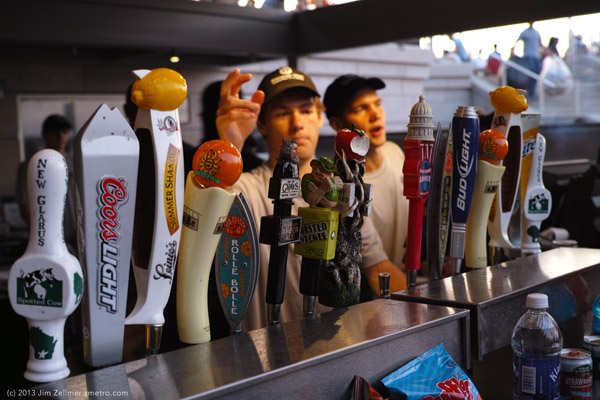
I have a preference for Gray Brewing’s Rathskeller Ale.
The terrace view is a bit different in March, particularly when the Statue of Liberty pays a visit.
DJ @ Wisconsin Union Terrace Sunset
Driverless tractors till high-tech farms
AAP:
“Of 280,000 farms in Germany, between 800 and 1,000 use optical sensors,” he says.
However, precision agriculture may have bumper times ahead.
“It offers enormous productivity gains and allows for a reduction of resource use at a time of growing environmental regulatory demands,” said Oliver Neumann, spokesman for agricultural equipment giant John Deere.A problem is that the equipment still doesn’t come cheap. Some high-tech combine harvesters can cost up to half a million euros.
Dirty Medicine How medical supply behemoths stick it to the little guy, making America’s health care system more dangerous and expensive.
hen Thomas Shaw gets worked up, he twists in his chair and kneads his hand. Or he paces about in his tube socks grumbling, “They’re trying to destroy us,” and “The whole thing is a giant scam.” And Shaw, the founder of a medical device maker called Retractable Technologies, spends a lot of time being agitated.
One of the topics that gets him most riled up these days is bloodstream infections. And with good reason—while most people rarely think about them, these are the most dangerous of the hospital-acquired bugs that afflict one in ten patients in the United States. Their spread has helped to make contact with our health care system the fifth leading cause of death in this country.
A few years ago, Shaw, an engineer by training, decided he wanted to do something to help solve this problem and quickly homed in on the mechanics of needle-less IV catheters. Rather than using needles to inject drugs into IV systems, most hospitals have moved to a new design, which involves screwing the threaded tip of a needle-less syringe into a specially designed port. The problem is that if the tip brushes against a nurse’s scrubs, or a counter, or the railing of a hospital bed, it can pick up bacteria. And the rugged threaded surface makes it difficult to get rid of the germs once they’re there. Often, the bacteria go straight into the patients’ bloodstream—which explains why, according to some studies, the rate of bloodstream infections is three times higher with needle-less systems than with their needle-based counterparts.
Who Will Disrupt Real Estate?
So where is the real disruption in real estate? Startups are taking on commercial real estate and apartment rentals all the time, but when it comes to private properties, we’re still basically stuck with the same sales model today as somebody who bought a house in the 60s. We’re still working with agents and pay them fees (directly as least as sellers – and indirectly as buyers), even though we often know more about a house and neighborhood then they do. They do, however, have the key to the house we want to see and unless there’s an open house, there is basically no other way to get into a place that’s for sale.
Real estate transactions are big and complicated (and you can bet your agent will often remind you that it’s the biggest financial decision you’ll ever make), but where is the startup that tries to change this or at least tries to make some aspects easier and more transparent? Sure, it’s a well-regulated industry with plenty of (local) quirks, but the same could be said for taxis and it looks like some companies have been able to change that landscape pretty effectively. If Airbnb can rent out houses, there sure must be a way to at least make home showings easier in the age of Lockitron (once it starts shipping) and internet-connected surveillance.
Don’t get me wrong – there are plenty of good real estate agents out there, but I can’t help but think that in the long run, real estate agents will go the way of travel agents. There will also be a need for a few good ones that can help you out in special circumstances and some people will always want to rely on them instead of handling things themselves. It took some ambitious startups to change how we book our travel today and it’ll take even more ambitious startups to change real estate as we know it.
There is a huge opportunity here, however, and I’m looking forward to seeing somebody try to really shake things up.
Tesla, fast charging and why it’s getting inconvenient for future EV drivers
Similar to Apple’s strategy, Tesla has been creating a closed ecosystem, and in Tesla’s case it’s around electric car charging. And that’s not so great for the electric car drivers of the future.
Now that’s all well and good for Tesla, but what about the entire EV landscape? Tesla’s supercharger utilizes a proprietary plug, and although the stations its planning to build will have four to six EV spots servicing any vehicle, four will be dedicated to Tesla. Imagine going to the gas station, and four of the pumps were reserved for BMWs. When the automakers get a say in the powering of their EVs, they are choosing to create closed systems that exclude their competition.
Recent Manufacturer & Supplier Self driving car surveys
According to Alliance poll results, consumers are still cool to automated or “self-driving” cars with 33 percent indicating that such cars are a good idea, 42 percent saying they are a bad idea, and 24 percent unsure. Many consumers are unsure about the importance of self-driving cars:
40 percent of respondents believe self-driving cars do not enhance safety.
24 percent say they enhance safety by limiting human error.
12 percent see them as important to allow elderly and disabled people to drive.
8 percent believe they liberate people to do other things in the vehicle.
16 percent are unsure of the importance of self-driving cars.
Today, the driver is responsible for controlling the vehicle, and consumers expect the same laws to apply for self-driving cars.
Polling shows strong consumer support for requiring the driver or operator of a self-driving vehicle to have a driver’s license (86 percent), for prohibiting the driver from texting/surfing the internet (72 percent), for not allowing the driver to be under 16 years old (86 percent) and for banning alcohol consumption while operating the vehicle (88 percent).
If a self-driving car were in an accident, who should be liable for the damage? About one third of respondents (31 percent) were unsure. According to the poll, 30 percent said the software company controlling the vehicle, 22 percent said the vehicle owner, 7 percent said the company that installed the equipment and 7 percent said the vehicle manufacturer.
I have been unable to find the raw poll information.
A more clear-cut worry surfaced in the poll: Privacy. About 75% of respondents said they were concerned that companies would use the software that controls a self-driving car to collect personal data, and 70% were worried that data would be shared with the government. Asked whether they were worried that hackers could gain control of a self-driving vehicle, 81% of the respondents replied they were either very or somewhat concerned about that threat, the Alliance says.
A summary of Cisco’s recent self driving car survey can be found here.
Stuff you shouldn’t do to your house
It’s usually good to stand out in real estate – but not for odd reasons. Here are some of the fun things I’ve seen during the business day on appraisal inspections. These are probably things to avoid doing to your house.
NFL Driveway: I am a huge sports fan and diehard sports talk radio listener, but spray painting a dozen stencils of your favorite team’s logo on your concrete driveway doesn’t make the neighborhood look good.
Regulation & Disruption: The New Innovation Battlegrounds Are City Hall And The State House
Colorado is currently considering proposals to outlaw Uber and other services that enable passengers to book a car service from their smartphones. Uber and its competitors face similar challenges from Los Angeles to Las Vegas to Washington, DC.
In May, the North Carolina State Senate voted unanimously to prohibit Tesla Motors, the innovative electric car company, from selling cars directly to consumers, including via the Internet. The Texas legislature recently retained similar prohibitions until at least 2015.
The Ecuadorian Library: or, The Blast Shack After Three Years
When you’re a professional spy hierarch, there are few things more annoying than these conscience-stricken Winston Smith characters, moodily scribbling in their notebooks, all about how there might be hope found in the proles somehow. They’re a drag.
See, dissidence is like Andrei Sakharov. Such a useful guy, modest, soft-spoken, brainy, built you a hydrogen bomb. This eerie device straight from hell even works, so it’s all good. Then all of a sudden he’s like: you know what? The noble science of physics shouldn’t harm mankind!
What kind of self-indulgent, fatuous gesture is that? Look here, Dr Labcoat: why was the public’s money given to you, if not to “harm mankind”? If physics was harmless, you wouldn’t have a damn salary!
That’s what life feels like for the NSA right now. That is the shoe Snowden laced on their foot. If you’re NSA, as so many thousands are, you’ve known from the get-go that the planet’s wires and cables are a weapon of mass surveillance. Because that is their inherent purpose! You can’t get all conflicted, and start whining that Internet users are citizens of some place or other! That is not the point at all!
